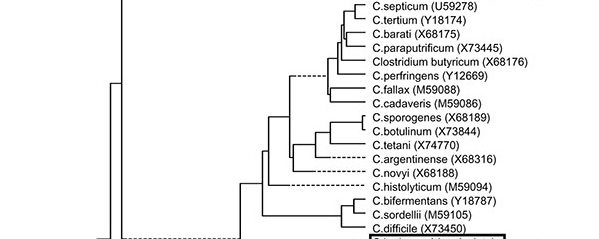Classification
Domain and Kingdom: Bacteria
The domain bacteria is a group in which all members have no
organelles, and a no true nucleus to hold the genetic material.
This group also typically contains circular DNA fragments
along with having other genetic material that can be transferred
between cells called plasmids.

Phylum: Firmicutes
The firmicutes are a sub group of bacteria that are gram positive
bacterium. To be gram positive the bacterial cell must make a large
peptidoglycan layer to surround the cell.
Clostridium perfringens is a gram positive bacteria which means
that when doing a gram stain the cells look purple under the microscope.
The reason the cells look purple is due to the process in which you do a
gram stain. After fixing the cells to a microscope slide
the sample is covered in crystal violet, washed off and covered in a destain such as ethanol. At this point only certain cells will look
purple, the sample is then covered in safrin, and finally iodine is used
to fix the color to the cells. if the cells were gram negative they
would appear a pink color due to the safrin, but as stated C.
perfringens is gram positive so it appear purple
Class: Clostridia
The classification of Clostridia is from bacilli by lacking aerobic
respirations. Currently all individuals under the class of Clostridia
are spore forming organisms. A spore is an encapsulated region inside of
the cell that is typically capable of withstanding various environmental
changes. It protects the genetic material and some basic cellular
machinery to start cellular replication for years. C. perfringens has been
discovered to create endospores which in some gram stains can be
identified by seeing a clear region in the cell. These regions can
either be near the poles of the organism or they could be found in the
dead center of the organism.
Order: Clostridiales
Any of various rod- shaped, spore forming, chiefly anaerobic bacteria.
The organisms in this group are typically at reducing sulfites.
Family:
Clostridiaceae
Many of the family Clostridiaceae are being moved out of this family.
This is do to newer molecular tools such as 16s ribosomes sequencing.
The groups found under this family are being altered to fit in various
other family groups. So this family group is currently under much debate
over if it should truly be a family or not.
Genus:
Clostridium
The species that fall under the genus name of Clostridium
are rod shaped from the Greek word kloster or spindle. There are
approximately 100 species that fall under this category. This includes
bacteria that are capable of fixing nitrogen in the soil to organisms
that are capable of causing necrotizing fasciitis.
Species: C. perfringens
Is a gram positive, spore forming, obligate anaerobe bacterial
organism. Which is capable of making various toxins
that when allowed to go systemic in an organism it can cause serious
health problems and have various physiological effects on the new host
organism.
